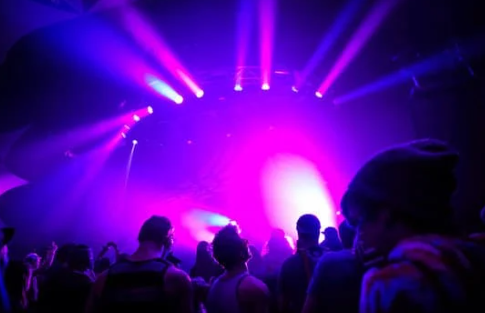Series 7: Jungle
Audience verticals are crucial in music marketing as they allow artists & labels to tailor their promotional efforts to specific groups of listeners who share common characteristics, interests, and preferences. By understanding the distinct tastes and behaviours of different audience segments, music marketers can create targeted strategies that resonate more effectively.
This approach enhances engagement, increases the likelihood of converting listeners into fans, and maximises the impact of marketing campaigns.
The main aesthetics of Jungle includes Street Art, Sound System Culture and Rave Fashion.
Vertical: Sound System Culture:
VERTICAL: Sound System Culture. Jungle is a genre of dance music that developed out of the UK rave scene and sound system culture in the 1990 as a dynamic fusion of fast breakbeats, heavy basslines, and reggae-inspired samples. With an abundance of culture surrounding the genre, here’s how Jungle might intersect:
Origin:
Jungle music originated in the United Kingdom in the early 1990s as a subgenre of electronic dance music. It evolved from breakbeat hardcore and was heavily influenced by reggae and dub music. Key factors contributing to its development included the use of breakbeats, sampling techniques, advancements in music production technology, and the vibrant DJ and rave culture of the time.
Reggae and Dancehall Influence:
Sound System Culture is deeply rooted in reggae and dancehall music, and these influences are present in jungle music as well. Fans of both genres appreciate the reggae-inspired rhythms, dub effects, and dancehall vocal samples found in jungle tracks.
Sound System Culuture:
The culture of sound systems, rooted in Jamaican traditions, is a key element in both Jungle and black music culture, enhancing the communal experience of the music. The Jungle scene embraces diversity, leading to collaborations that blend cultural traditions and foster innovation. Jungle music, like hip-hop and reggae, can address social and political issues.
Dubplate Culture:
Dubplates, exclusive and customised music tracks, are highly prized in both jungle music and Sound System Culture. Fans of these subcultures appreciate the exclusivity and unique tracks that are often played at events.
Sound System Events:
Jungle music is known for its powerful bass and immersive sound, which aligns with the core principles of Sound System Culture. Fans of Sound System Culture are drawn to events where jungle music is played because of the emphasis on bass-heavy, high-quality sound systems.
Community and Unity:
Both jungle music and Sound System Culture foster a sense of community and unity among their audiences. Attendees often share a common passion for music, dance, and a welcoming, inclusive atmosphere at events.
Outdoor Festivals:
Many Sound System Culture events and jungle music festivals take place in outdoor settings, where fans can experience the music and culture in a natural environment. These settings create opportunities for crossover between the two audiences.
History and Heritage:
Fans of both jungle music and Sound System Culture may appreciate the historical significance and cultural heritage associated with these subcultures. Learning about the roots and evolution of these movements can deepen their connection to the music and culture.
Collective Experience:
Sound System events and jungle music parties often provide a collective and immersive experience, with attendees coming together to enjoy music, dance, and a shared cultural experience. This shared experience can strengthen the bonds between fans of both subcultures.
Vertical: Street Art
VERTICAL: Street Art, here’s how Jungle music might intersect.
Underground Scene:
Jungle music and street art have their origins in underground movements. They often exist outside of mainstream culture and are driven by a DIY (Do It Yourself) ethos. Fans of underground music and art scenes, in general, may find common ground in their support for alternative and independent expressions.
Event Collaborations:
Promoters and event organisers occasionally collaborate to bring together jungle music and street art at the same events. This can create a multidimensional experience where attendees can enjoy live music performances while witnessing live art installations or graffiti painting.
Shared Spaces:
In some underground settings, spaces that host jungle music events may also become canvases for street artists. This overlap of spaces can lead to encounters between fans of both subcultures, fostering a sense of community and shared appreciation for underground artistry.
Street Art Murals at Music Events:
Street artists may be invited to create murals or graffiti art at jungle music events or music festivals. This not only adds to the visual appeal of the event but also allows for interaction and engagement between fans of both forms of art.
Street Art as Visuals for Jungle Music Performances:
Some jungle music events incorporate street art visuals as part of their stage design and visuals. This can enhance the overall sensory experience for the audience and create a unique atmosphere that resonates with both music and art enthusiasts.
Collaborative Projects:
Street artists and musicians may collaborate on creative projects, such as album artwork, music videos, or promotional materials. These collaborations can introduce fans of one subculture to the other.
Online Communities:
Online communities and social media platforms provide a space where fans of both jungle music and street art can connect, share their interests, and discover events or artists that align with their passions.
Artistic Expression:
Both subcultures value artistic expression as a means of self-identity and cultural commentary. Fans appreciate the creativity, innovation, and self-expression that are integral to both jungle music and street art.
Youth Culture:
Both jungle music and street art have a strong presence in youth culture. Young people who are drawn to underground lifestyles, music, and art often find resonance in both subcultures.
Vertical: Rave Fashion
VERTICAL: Rave Fashion, here’s how Jungle music might interact.
Colourful and Eclectic Style:
Rave fashion is known for its vibrant and eclectic style, characterised by bright colours, bold patterns, and eye-catching accessories. Jungle music events often embrace a similar aesthetic, with attendees dressing in colourful and expressive outfits that reflect the high-energy nature of the music
90s Nostalgia:
Both Jungle music and rave fashion have strong ties to the 1990s, a period when both subcultures gained prominence. Many fans of jungle music and attendees of rave events embrace a nostalgic approach to fashion by wearing clothing and accessories reminiscent of the ’90s rave era.
DIY and Creative Expression:
Rave fashion encourages creative self-expression, often involving DIY clothing customization, unique accessories, and imaginative makeup. Jungle music enthusiasts share this DIY ethos and often express their creativity through their attire when attending events.
Comfort and Danceability:
Practicality is essential in both jungle music and rave fashion. Attendees prioritise comfort and freedom of movement, as dancing is a central activity at both jungle music parties and rave events. Loose-fitting, breathable clothing and comfortable footwear are common elements in the fashion choices of both subcultures.
Streetwear and Sportswear:
Elements of streetwear and sportswear often find their way into both jungle music and rave fashion. This includes baggy pants, oversized hoodies, and athletic sneakers, which are comfortable for dancing and contribute to the casual yet stylish appearance of attendees.
Cultural Fusion:
Jungle music’s multicultural influences can sometimes be reflected in rave fashion choices. Attendees may incorporate elements from different cultures into their outfits as a nod to the diverse music and cultural influences present in jungle music.
In summary, audience verticals are essential for effective marketing, engagement, and success in the music industry. By identifying and catering to different segments of your fanbase, you can create meaningful connections, increase your impact, and build a sustainable and rewarding career in music.

